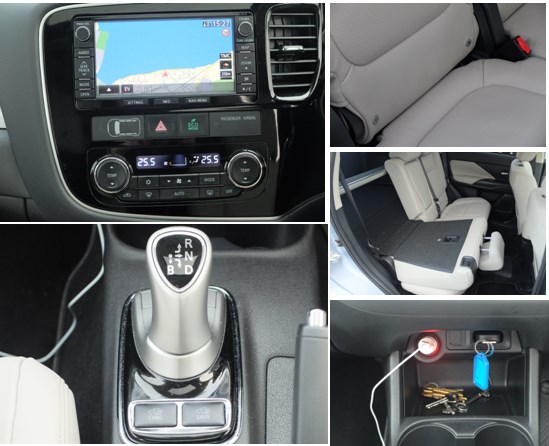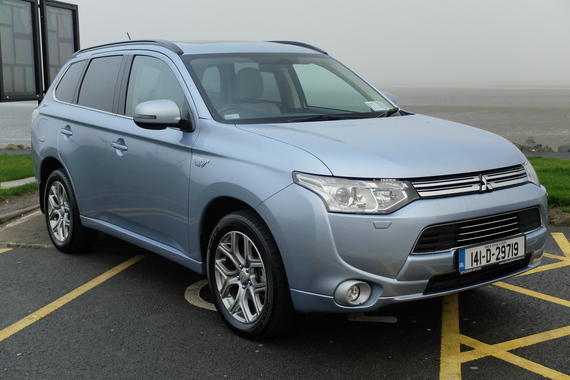 Fully electric cars are often not a direct fit for a modern Mum and her family. With a limited driving range on a full battery and long charging times in some cases, they sometimes don’t offer Mums who are on the go dropping and collecting from early morning until well into the evening, as well as perhaps going to work, too, enough flexibility. Mitsubishi might have found a workable solution though – the exciting new Outlander SUV is powered by chargeable batteries, and when the charge runs out, a traditional engine kicks in so you can continue your journey.
Fully electric cars are often not a direct fit for a modern Mum and her family. With a limited driving range on a full battery and long charging times in some cases, they sometimes don’t offer Mums who are on the go dropping and collecting from early morning until well into the evening, as well as perhaps going to work, too, enough flexibility. Mitsubishi might have found a workable solution though – the exciting new Outlander SUV is powered by chargeable batteries, and when the charge runs out, a traditional engine kicks in so you can continue your journey.
Clever, eh? In principle, Mitsubishi has engineered the solution to the problem most people have with electric cars, ‘range anxiety’, i.e. how far can you travel before the batteries run out and leave you stranded. The Outlander PHEV does not suffer from other common electric car issues, such as reduced interior space and strange looking styling. Indeed the PHEV has just about the same amount of passenger and luggage space as the regular diesel version of the Outlander, and the styling looks regular and unremarkable.
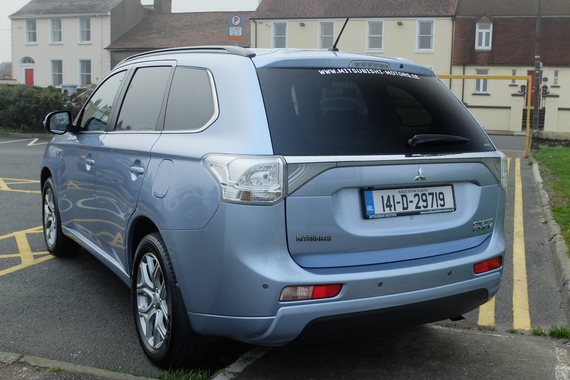 So how does it work in practice? There are three charging options. You can plug the car into a regular three point socket in your house, a full charge taking about five hours and costing approximately €1.50. Alternatively, there are 1,500 ESB car charging points located around Ireland, and once you have registered your Outlander to use them you can currently charge up at any of them for free. Again the charge time is roughly 4-5 hours. ESB have started to roll out ‘fast charge’ points at motorway service stations and busier roads, meaning those on longer journeys can charge their batteries up to 80% in about 25 minutes when they grab a coffee or a bite to eat. However, the most practical way to integrate your Outlander PHEV in to family life has to be to have a car charging point installed free at your home by ESB, which they are offering to a limited number of customers. This means that you won’t have to have doors or windows open in the house to charge the car, and you can leave the car charging overnight with no disturbance to your routine. A full charge using the home charge point costs about €1.50.
So how does it work in practice? There are three charging options. You can plug the car into a regular three point socket in your house, a full charge taking about five hours and costing approximately €1.50. Alternatively, there are 1,500 ESB car charging points located around Ireland, and once you have registered your Outlander to use them you can currently charge up at any of them for free. Again the charge time is roughly 4-5 hours. ESB have started to roll out ‘fast charge’ points at motorway service stations and busier roads, meaning those on longer journeys can charge their batteries up to 80% in about 25 minutes when they grab a coffee or a bite to eat. However, the most practical way to integrate your Outlander PHEV in to family life has to be to have a car charging point installed free at your home by ESB, which they are offering to a limited number of customers. This means that you won’t have to have doors or windows open in the house to charge the car, and you can leave the car charging overnight with no disturbance to your routine. A full charge using the home charge point costs about €1.50. The big question though, is does buying the Outlander PHEV really make sense over the diesel version, or a similarly sized SUV? The big drawback with the PHEV over the regular Outlander is that it does without a third row of seats. In the regular car these are quite small and only useful for small children, but they are handy for Mums for play dates or if you share the school run with your neighbours.
The big question though, is does buying the Outlander PHEV really make sense over the diesel version, or a similarly sized SUV? The big drawback with the PHEV over the regular Outlander is that it does without a third row of seats. In the regular car these are quite small and only useful for small children, but they are handy for Mums for play dates or if you share the school run with your neighbours.
The main consideration is really a financial one. If you are not going to embrace life with an electric car and commit to charging it every day, you will quickly find that it is nowhere near as cheap to run as you expected. The Outlander PHEV uses a 2 litre petrol hybrid engine once electric power runs out, and if you never charge the car it is about 40% less fuel efficient than the diesel car. We had no ESB home charge point during our week with the Outlander, so we had to make do with charging it from the porch, which is more awkward.
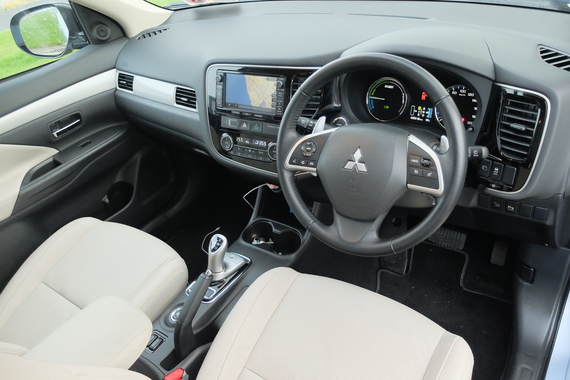 Our recommendation is that if you are considering buying one; have the charge point installed at your home so that charging the car is easy. If you do, you will quickly find that you can drive up to 300km per week (average enough mileage for a family car in the city) for about €9 worth of electricity. The equivalent mileage in a diesel would cost about €25. So over a year you could potentially save around €800-€900 on fuel. Add in the €110 you save on road tax with the PHEV over the diesel Outlander and you could be looking at savings of €1,000 per year. The Outlander PHEV costs €41,950, €2,000 more expensive than the diesel model. So in theory, if you charge up every day, you could have a real saving on the running costs of the PHEV in two years. It is an exceptionally well equipped car, loaded with standard kit and also a doddle to drive around town with the fully automatic gearbox. This is the first electric car sold in Ireland that could genuinely slot easily into family life.
Our recommendation is that if you are considering buying one; have the charge point installed at your home so that charging the car is easy. If you do, you will quickly find that you can drive up to 300km per week (average enough mileage for a family car in the city) for about €9 worth of electricity. The equivalent mileage in a diesel would cost about €25. So over a year you could potentially save around €800-€900 on fuel. Add in the €110 you save on road tax with the PHEV over the diesel Outlander and you could be looking at savings of €1,000 per year. The Outlander PHEV costs €41,950, €2,000 more expensive than the diesel model. So in theory, if you charge up every day, you could have a real saving on the running costs of the PHEV in two years. It is an exceptionally well equipped car, loaded with standard kit and also a doddle to drive around town with the fully automatic gearbox. This is the first electric car sold in Ireland that could genuinely slot easily into family life. Is there loads of storage space?
Is there loads of storage space?
The Outlander has a wide, square boot with a high load shelf, so sliding things in and out is easy. There are some SUV’s which offer slightly more luggage space, but in truth the Outlander will be more than big enough for most families. The back seats can be folded to create enough space for a couple of bikes.
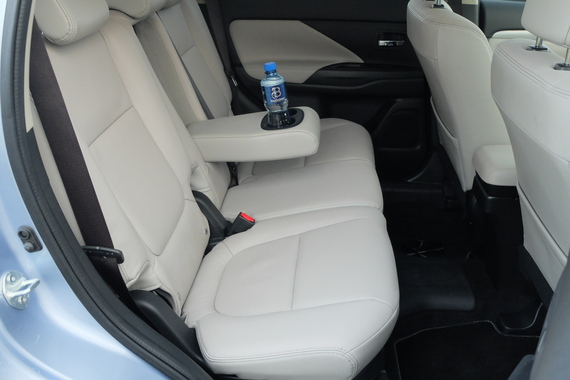 Is it baby friendly?
Is it baby friendly?
The tall roof and large amount of rear legroom mean strapping in a baby is not awkward at all. There are two ISOFIX child seat mounts with ‘top tethers’ to stop a child seat lurching forward in an accident. The front passenger airbag can be disabled so you can fit a rear facing child seat beside you if that suits you better. The high rear seats and large rear windows mean young children in the back can see lots outside.
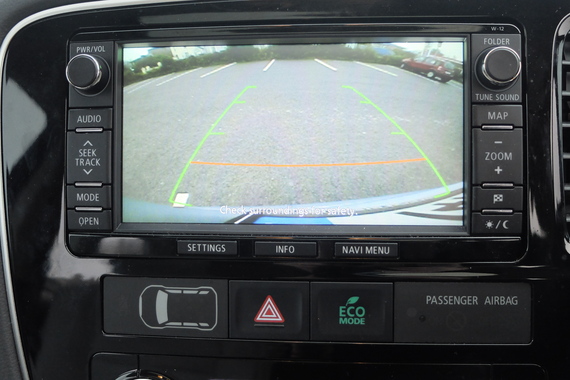 Is parking easy?
Is parking easy?
Our test car was fitted with both rear sensors and a reversing camera which makes reversing into tight spaces easy, and it is a very safe way to make sure there are no small children behind you when you are reversing at the school. The camera is only standard on the higher spec model. The bonnet of the Outlander is quite long, but you have a very clear view through the front windows so ‘front first’ parking should not cause most drivers a problem. The Outlanders large windows mean driver visibility is much better than some modern SUV’s like the Hyundai Santa-Fe.
What about safety?
The Outlander PHEV scored a very impressive 84% in the child protection section of the Euro Ncap safety test with testers noting that children were well contained in their seats in an impact there was minimal risk of their head hitting any part of the car in a crash. Hill start assist, a drivers knee airbag and full length roof airbags are all standard on the PHEV, as is a four wheel drive system which improves road holding on muddy, damp terrain or in the snow or ice.
 Verdict:
Verdict:
Thumbs Up:
The first practical electric car in Ireland for families
Cheap to run if you charge the batteries regularly
Easy to drive for such a big car
Looks great and has plenty of space
Thumbs down
No reversing camera on the base model
Diesel model may still suit some families better
Mummypages Ratings:
Baby friendliness: 3.5/5
Safety: 4.5/5
Cool rating: 5/5
Passenger and storage space: 3.5/5
Car park friendliness: 4/5
Value for money: 4/5
Overall rating: 24.5/30
Statistics: (Republic of Ireland market)
Price (starting from / our test car): €41,950 / €47,450
Average Fuel Economy and tax: 149 mpg / €170 per year
Warranty: 5 years / 100,000 kilometres
Isofix baby seat mounts: 2
Seats suitable for adults (excl driver): 4
Seats suitable for kids only: 0
